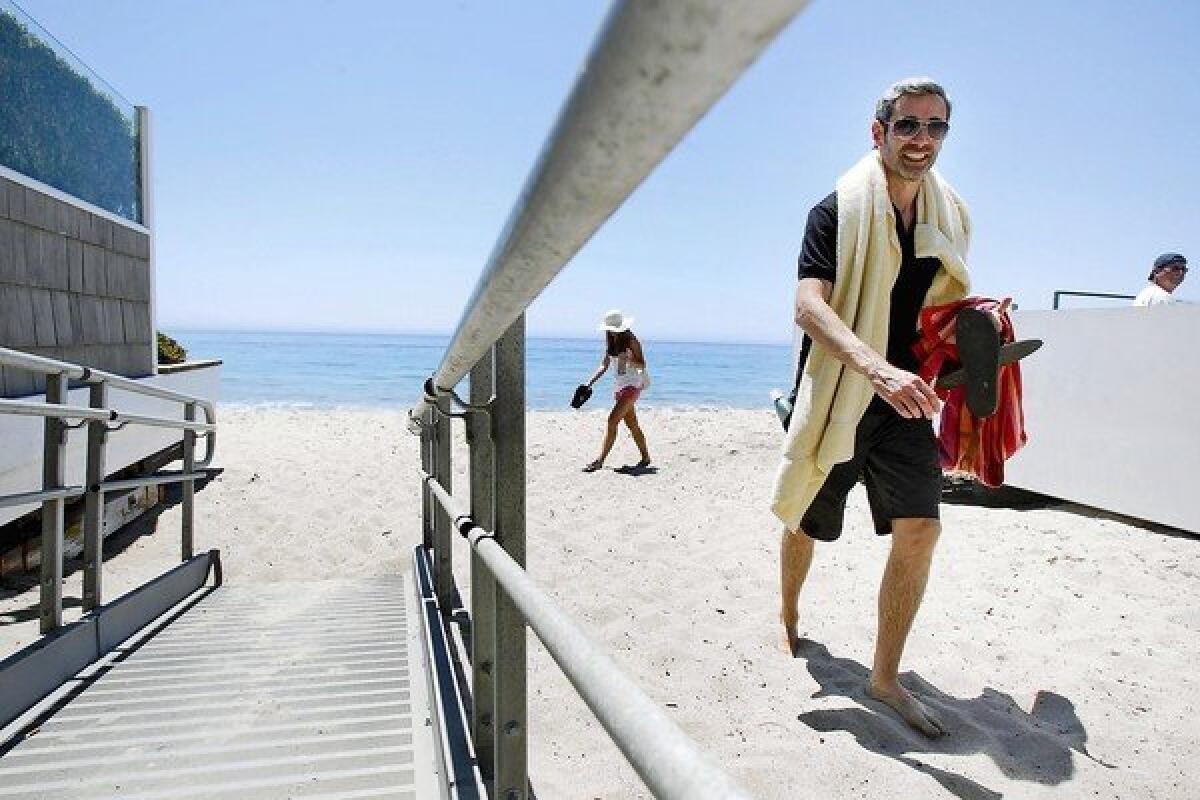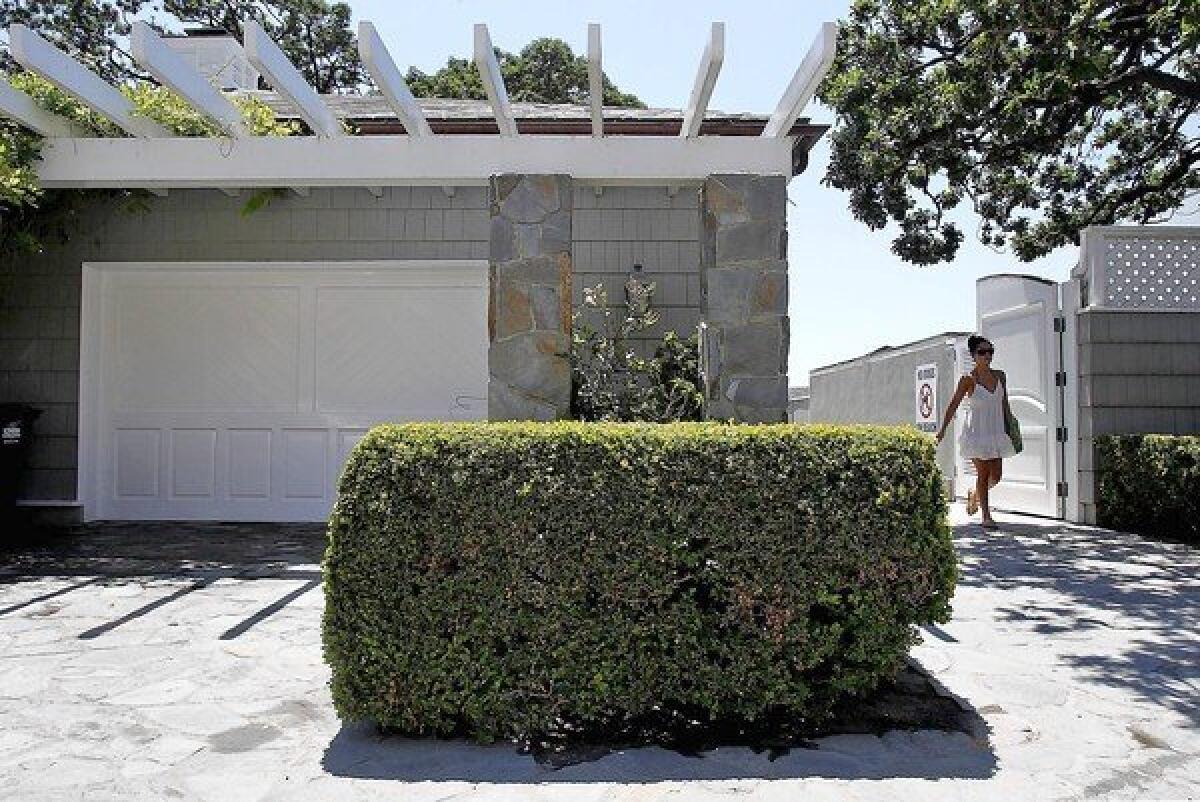Malibu beach guide helps sort out parking, access, all in an app
Jenny Price has long decried the lack of access to Malibu’s beachfront. Now she’s developed a smartphone app to help visitors outfox privacy-loving millionaires and open up the coast once and for all.
- Share via
When environmental writer Jenny Price first began scouting for ways to get to Malibu's beaches, she drove up and down Pacific Coast Highway but did not spot a single sign pointing "this way to the beach."
Shrubbery obscured stairway openings. "Private property — no parking" signs dotted public streets. Once she got to the sand, she found "No trespassing" and "Private beach" placards. A security guard at Broad Beach shooed her away.
"You have these miles of beachfront in Malibu," she said. "It's one of the most egregious examples of privatization of public space in Los Angeles."
For the last decade, Price has written opinion pieces about tactics homeowners use to make beachgoers feel like trespassers. She has posted beach guides online. She has helped lead Malibu beach tours. She has made it her mission to show people how to enjoy Malibu's 27 miles of oceanfront, even the beaches hidden by the homes of the well-heeled.
Now she has gathered her years of hard-won knowledge into a smartphone app called Our Malibu Beaches. Her goal is to help beachgoers outfox privacy-loving millionaires and open up the coast once and for all.

Price, 52, a St. Louis transplant who lives on a Venice walk street, has trouble explaining her fascination with the beach. "I'm more of a mountain person," she said, "but I always end up at the beach."
She comes by her dedication to social justice naturally. When she was a child in the 1960s, her parents fought for racial equality in St. Louis, and her attorney father defended people on the McCarthy-era black list.
Price and co-developer Escape Apps plan to release the program for iPhones and iPads next month and hope to expand to Android devices.
The app leads users along Lechuza, Escondido, Carbon and other beaches, house by house, to aid in locating spots where they can legally plop their towels and pop open sodas.
It helps them divine which "no parking" signs are legitimate and which have been placed illegally by homeowners to scare away beachgoers. It encourages users of Carbon Beach, in particular, to move the orange cones that residents often place — illegally — to block off public parking spots.
At music mogul David Geffen's gray-shingled compound on PCH, Price points out a curb cut that leads to a short driveway and a dazzlingly white, and sealed, garage door.
"He's blocking off about four public spaces," she said. (The California Coastal Commission said it asked the California Department of Transportation to look into revoking Geffen's encroachment permit in front of the fake door but got no response.)
Just west of that garage door, white wooden gates look like an elegant extension of Geffen's home. From sunrise to sunset, however, they open onto a 9-foot-wide concrete walk that leads to Carbon Beach, a.k.a. Billionaires Beach, where visitors might catch a glimpse of bigwigs such as Eli Broad, Haim Saban and Jeffrey Katzenberg.
The opening of the gates in 2005 marked a rare victory for beachgoers.
Geffen had agreed in 1983 to allow an access path — a "vertical easement" — to run alongside his property in exchange for the state's permission to add a swimming pool and other amenities. Then he changed his mind and filed suit to fight efforts to open the walk. The case gained national notoriety when Garry Trudeau lampooned the DreamWorks co-founder as "Lord Geffen" in his "Doonesbury" comic strip, which featured former sun worshiper Zonker Harris' return to Malibu. Geffen eventually relented to end the court battle.
Price cheekily labels this the Hooray for Hollywood Moguls path to the beach. (Another public entry, about a 25-minute walk west of Geffen's, was named for Zonker Harris after an earlier tussle over access.)
Aside from an easy-to-miss brown-and-white "coastal access" sign on a light pole planted in the sidewalk, there's nothing to indicate that this Geffen-adjacent walk is one of three public gateways to Malibu's most coveted coastal strip.


Laurent Puechguirbal leaves Carbon Beach in Malibu via a public access path. This stretch of sand is also called Billionaires Beach, where visitors might catch a glimpse of bigwigs such as Eli Broad, Haim Saban and Jeffrey Katzenberg.
One recent morning, Price led the way from the sidewalk in front of Geffen's house to the sand as she talked about the complex history of public beach access in Malibu. She wore an elaborate brace on her right knee, made necessary by an "ornithology injury" she suffered while studying white-winged trumpeters in southeastern Peru for her senior thesis at Princeton University.
"I fell 30 feet from a palm tree in the Amazon and crushed the top of my tibia," she said.
In 1972, voters concerned about unfettered development along the state's coastline overwhelmingly approved Proposition 20, which established the Coastal Commission. Four years later, state lawmakers extended the agency's authority indefinitely through the California Coastal Act.
Since then, the commission and the Coastal Conservancy have worked to open more than 1,000 coastal entry points throughout the state. Property owners have resisted — padlocking gates, in some cases — citing concerns about safety, trash and sanitation on beaches without lifeguards or public toilets.
The state recommends one public walkway for every 1,000 feet of beach. By that guideline, Price said, Malibu's 20 miles of privately developed coastline should have about 105 entries. There are 17, including some owned by the county. Twenty additional passageways have been set aside, but either the commission has not taken action on them or property owners have fought to keep them closed.
You have these miles of beachfront in Malibu. It's one of the most egregious examples of privatization of public space in Los Angeles."— Jenny Price,
Our Malibu Beaches co-developer
Under California law, beach visitors may walk within the mean high tide line, with the rule of thumb being that wet sand equals public beach. In addition, many property owners have granted easements on dry sand running parallel to the water. Our Malibu Beaches will help sort it all out.
For the uninitiated, Price said, open gates can still be hard to spot from the road. Two entries at Lechuza look like private locked gates. "You have to get up close to see they're not locked," she said, "and even then it's ambiguous because there's private signage along with the public."
Parking can be just as difficult to find.
On Pacific Coast Highway near Carbon Beach or by Geoffrey's restaurant (near the entry to Escondido Beach), for example, she said, "there are a lot of suspicious 'no parking' signs." Malibu City Manager Jim Thorsen said the city has inventoried "no parking" signs on PCH but cannot determine which signs are valid.
Price mentions one unexpected hidden gem that's not an official access way but is known to the Coastal Commission: the small, Caltrans-owned beach lot with an unlocked gate at Las Flores Beach, a sweet little cove.
The idea for the app came from Ben Adair, co-founder of Escape Apps, who suggested Price adapt the online guide she had created for LA Observed, a local news blog. Earlier this month, the team launched a Kickstarter campaign. If they surpass their $30,000 goal, they will develop a version for Android, offer the program for free for the summer and perhaps develop a version for the Web. More than making money, Adair said, their aim is to get "a really cool project out there."

To prepare the app, Price made more than a dozen research trips to the beach, taking copious notes on scrap paper. She spoke to public agencies, read up on public access laws, consulted other activists and studied Coastal Commission guidebooks.

A beachgoer passes through white wooden gates that look like an elegant extension of music and film mogul David Geffen's home at Carbon Beach in Malibu. The opening of the gates in 2005 marked a rare victory for beach visitors.
Linda Locklin, the California Coastal Commission's manager of coastal access programs, fact-checked the entries.
She alerted Price to a key update. While Price was writing the app, the commission was embroiled in a long-running legal battle over an entry on Carbon next to property owned by Lisette Ackerberg, the widow of Minnesota developer Norman Ackerberg (a founder of Santa Monica Baykeeper, a conservation group now called Los Angeles Waterkeeper). Ackerberg agreed in March to pay $1.1 million and to build a paved pathway, by December 2014, at the edge of her property. The job will entail moving a tennis court, lights and landscaping.
After 15 years in Los Angeles, Price will soon say farewell to the Malibu coast. She will head to Munich on a fellowship that will allow her to write a book about contemporary environmentalism called "Stop Saving the Planet!" After that, she'll become the visiting humanities professor at the Princeton Environmental Institute.
"I did not intend to drop this app bomb on everybody and then leave," she said, "but that's how it worked out."
Sign up for Essential California
The most important California stories and recommendations in your inbox every morning.
You may occasionally receive promotional content from the Los Angeles Times.









